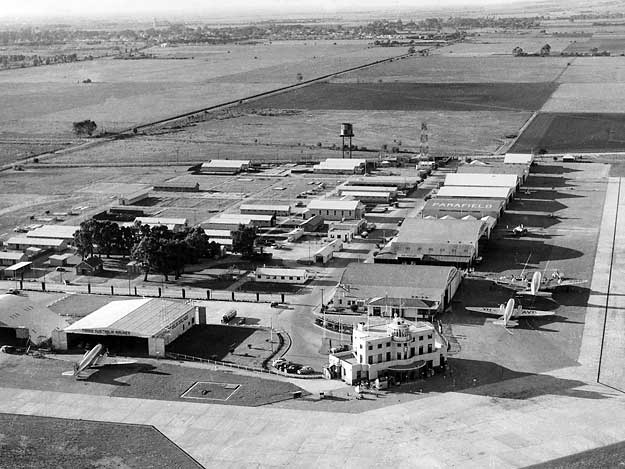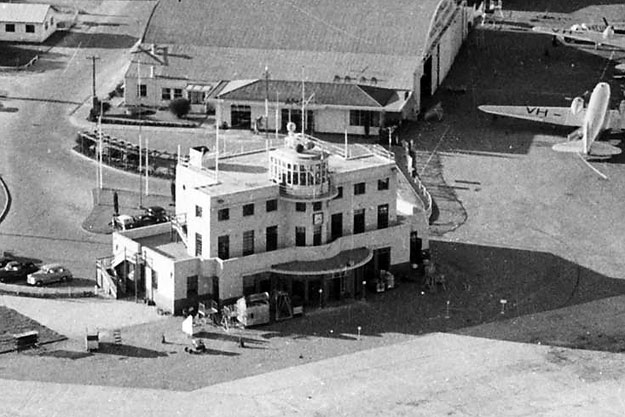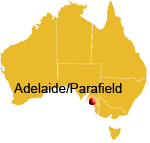
This superb photograph of Adelaide's Parafield aerodrome dates from 1948.
Noted aviation historian and retired Air Traffic Controller Geoff Goodall,
who grew up literally as the 'boy on the fence' at Parafield, provides
the following identification of the hangars and buildings, working north
(away) from the Ops/Admin/Control Tower building:
- "1. ANA hangar, became Royal Aero Club of SA
- 2. Guinea Airways, became United Aviation, later Aerokair then Rossair. That's Guinea's last Lockheed 14 VH-AEW parked out on the tarmac.
- 3. Those
4 Nissan huts were certainly still there until the '80s at least, given
various uses.
- 4. Bellman hangar with "Parafield" painted on roof: I don't know who used it in 1948 but it was used by Robby's Aircraft for aircraft storage by the time I started snooping around Parafield in the early '60s. It had Mac Job's Lockheed 12 VH-FMS on trestles up the back, Anson VH-DOB stored, and various parked Austers etc.
- 5 &
6. Robby's Aircraft (Frank Robbiliard) training with Avro Cadets, Tigers
and Ryan STMs and the first aerial agricultural operator in SA with
Cadets and Tigers.
- 7. Smaller
hangar: was used for glider maintenance and wood/fabric components repair
by 1960s.
- 8. Small top hangar: general use by the 1960s. Visiting aircraft parked up there and on the grass opposite.
"The TAA hangar next to the Tower [to the left in the photo above] became Aviation Services (SA) Ltd hangar in the '50s when they were SA Auster agents. By 1960 they had set up country flying schools in competition with the Aero Club using Chipmunks, and were also active Beagle agents: their hangar was always packed with rag and tube aircraft and I never saw a Cessna or Piper in there.
"Then the igloo hangar, which was built by RAAF in WW2 and by 1948 would have been in use with Department of Aircraft Production (DAP) who built the adjoining two very large hangar and office complexes (out of the photo) for Dakota overhauls for RAAF. DAP continued this work for RAAF & RAN into the '70s.
"These DAP hangars are where the DCA Lodestars were civilianised. In 1951 the Lockheed 14 VH-AEW and the third DCA Lodestar were parked abandoned next to that clump of trees behind the DAP hangars.
"All
of those huts behind the hangar rows were put in by RAAF during WW2, and
I recognise a number of them that survived into the '70s at least. They
were used by Aero Club, Rossair, and Robby's for storage, and I remember
one large hut had 3 crashed aero club Chippie wrecks stashed inside."
Roll your mouse over the main buildings or significant features in the photos above and below for identification and, in some cases, more information.
Compare with another aerial photo from 1965

The enlargement above shows the art-deco Ops/Admin building with its Control
Tower cab on the roof. This building, and similar buildings constructed
at Brisbane/Archerfield and Sydney/Mascot, was built in 1940. They were
the first purpose-built Control Towers in Australia. Even in 1948, control
of aerodrome traffic was largely visual. General directions, such as the
circuit in use, were given using the signal mast and coloured cane balls
that can be seen on the Tower roof, as well as the signal
square which can be seen in the upper photo to the left of the Tower.
The building also housed Aeradio, and a forest of HF receiver masts can
be seen behind the building. The ground floor was a passenger lounge/waiting
room.
Click here for another image of this building from the 1948-49 Annual Report and photos from 1940, 1963 and 1971
(Photo: CAHS collection)
Back to
the main Airports
and Aerodromes index or
Air Traffic Services index
If this page appears without a menu bar at top and left, click here
